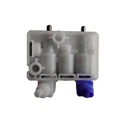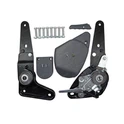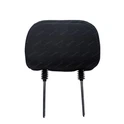The safety of vehicle operators is a central worry for makers and administrative bodies the same. One basic part of guaranteeing safety is the truck seat, which should go through a thorough testing and check cycle to guarantee it fulfills the highest standards of quality and performance.In this blog post, we will explore the various detection methods and tests that the Safety Truck Seat goes through to ensure its reliability and effectiveness.
Visual Inspection
The first step in the detection process is a thorough visual inspection. This involves a comprehensive examination of the seat's components, looking for any signs of improper alignment, damage, or cosmetic flaws. The overseers cautiously look at the seat's construction, upholstery, and equipment to guarantee that everything is in perfect condition and prepared for additional testing.
During the visual examination, the experts give close consideration to the arrangement of the seat's different parts, guaranteeing that they are appropriately gotten and situated according to the plan determinations. Any misalignment or indications of mileage can be a sign of potential issues that should be tended to before the seat can be endorsed for use.
In addition to the structural components, the inspectors also examine the seat's upholstery and other visible elements for any signs of damage or defects. This includes checking for tears, discoloration, or any other visual imperfections that could compromise the seat's appearance or comfort.
Dimensional Verification
Once the visual inspection is complete, the next step in the detection process is to verify the seat's dimensions. The dimensional verification process is crucial because the Safety Truck Seat must fit properly within the vehicle's interior.
During the layered confirmation, the experts utilize an assortment of estimation devices, like calipers, micrometers, and direction estimating machines, to assemble exact information on the seat's aspects. This information is then contrasted with the plan determinations to guarantee that the seat satisfies the expected guidelines.
Functional Testing
After the dimensional verification, the Safety Seat undergoes a comprehensive functional testing process. This involves testing the seat's movable components, such as the adjustment mechanisms and suspension systems, to ensure they are functioning correctly and smoothly.
The functional testing process is designed to mimic the real-world conditions that the seat will encounter during its lifetime. This includes testing the seat's ability to adjust to different positions, its response to various loads and forces, and its overall durability and reliability.
During the functional testing, the technicians observe the seat's performance and make note of any issues or irregularities. They may also conduct specific tests, such as measuring the force required to adjust the seat or evaluating the responsiveness of the suspension system, to ensure that the seat meets the established performance criteria.
Strength and Durability Testing
One of the most critical aspects of the Truck Seat's detection process is the strength and durability testing. This involves subjecting the seat to a series of simulated load tests and fatigue cycles to evaluate its structural integrity and ability to withstand the stresses encountered during real-world use.
The strength testing process typically involves applying various loads and forces to the seat, such as static and dynamic loads, to assess its ability to support the weight of the occupant and any additional cargo or equipment. The technicians may also conduct specific tests, such as sled tests or impact tests, to evaluate the seat's performance under extreme conditions.
The durability testing, on the other hand, is designed to evaluate the seat's ability to withstand repeated use over an extended period of time. This involves subjecting the seat to a series of fatigue cycles, where the seat is repeatedly loaded and unloaded to simulate the wear and tear it would experience during its lifetime.
Throughout the strength and durability testing process, the technicians closely monitor the seat's performance, looking for any signs of structural degradation, material fatigue, or other issues that could compromise the seat's safety and reliability.

Safety System Verification
The final step in the detection process for the Safety Seat is the verification of its safety systems. This involves testing the seat's various safety features, including the seatbelt system and energy-absorbing components, to ensure that they meet or exceed the applicable safety standards.
The seatbelt system is a critical component of the Truck Seat, as it is responsible for restraining the occupant in the event of a collision or sudden deceleration. The technicians test the seatbelt's functionality, including its ability to lock and release, as well as its strength and durability under various load conditions.
In addition to the seatbelt system, the Safety Seat also incorporates energy-absorbing components, such as crumple zones or energy-absorbing foams, that are designed to help mitigate the forces experienced by the occupant during a crash. These components are tested to ensure that they perform as intended and provide the necessary level of protection.
The safety system verification process may also involve testing the seat's ability to withstand specific types of impacts or collisions, such as frontal or side impacts, to ensure that it provides the required level of protection for the occupant.
By undergoing this rigorous testing and verification process, the Safety Truck Seat can provide a high level of confidence and reassurance to vehicle owners and operators, knowing that their safety and that of their passengers is a top priority.
To learn more about YSR seats, please contact us at sales@ysrseats.com.
References:
1. Automotive Engineering Fundamentals. Richard Stone and Jeffrey K. Ball. 2004.
2. Automotive Chassis Engineering. Vivek Dwivedi. 2015.
3. Vehicle Safety Design. John Happian. 2019.







